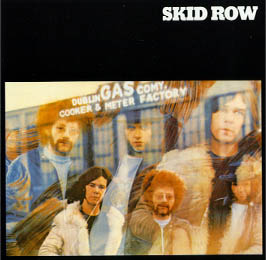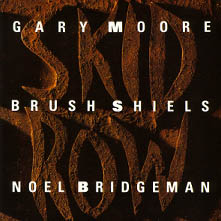
Week of December 7, 1997

Personnel:
Noel Bridgeman - Drums
Gary Moore - Guitar, Vocals
Brush Shiels - Bass, Vocals
Paul Chapman - Guitar, Vocals
Albums:
Skid (CBS 63965) 1970
34 Hours (CBS 64411) 1971
Alive And Kicking (Release RRL 8001) 1976
Gary Moore, Brush Shiels, Noel Bridgeman (rec. 1972, rel. 1990) CD, Castle
ESSCD025
45s:
Sandie's Gone, Parts 1 & 2 (CBS 4893) 1970
Night Of The Warm Witch/Mr. De-Luxe (CBS 7181) 1971
Guitarist Gary Moore fronted this Irish progressive blues trio who had a good live following but never really broke through with their vinyl, although their first album sold well enough to get into the album charts! It was an average amalgam of mellow rock, heavy blues and even had a ragtime-style guitar piece. When Moore left in 1971, he was replaced by Paul Chapman, previously with South Wales band The Universe. This line-up cut an unissued album (later rel. on CD by Castle, see above). Chapman was later in UFO and Lone Star. Moore was later in Thin Lizzy, G-Force and recorded as a solo artist.
Taken from The Tapestry of Delights - The
Comprehensive Guide to British Music of the Beat, R&B, Psychedelic and
Progressive Eras 1963-1976, Vernon Joynson
ISBN 1 899855 04 1
Both Skid Row's LPs feature the young guitar talent of Gary Moore. Formed in 1967,
the quartet with Moore, Brush Shiels (b), Nollaug Bridgeman (dr) and Bernhard
Cheevers (g) came from Dublin. Described  as the only serious competitor to
Rory Gallagher's Taste the band
used strong blues-rock riffs on a solid rock ground.
as the only serious competitor to
Rory Gallagher's Taste the band
used strong blues-rock riffs on a solid rock ground.
At the end of the sixties Skid Row went to London to become an important part of the British blues boom. At that time the original lead singer Phil Lynott had left the group, and Brush Shiels took his place. The first single was released on the Song label and was called "New Places, Old Faces". It was a fine work of Moore's 12-string guitar art. The next single "Saturday Morning Man" made the charts on a minor level and helped the band get in contact with a major company like CBS.
They started with the single "Dandy's Gone Part I". It was a bluesy neo-psychedelic piece of hard modern rock music, and it shows the enormous talent of Gary Moore once again. At this point Skid Row went into the studio and took eleven hours to produce the debut album, "Skid" with a strange, but fascinating mixture of raw blues and progressive jazz rock with tribal undertones.
Skid Row was a band that never really made it to the top, but always had
a strong loyal following. The band toured two times in the USA and Europe.
In between these tours they
 released
their second and last album, "34 Hours". Indeed, they only needed 34 hours
to create this little masterpiece. Brush Shiels used his bass as a melody
instrument, inspired by the jazz sounds of Dave Brubeck and Oscar Peterson.
On the other hand, Gary Moore was definitely bringing forth the hard rock
influences by using such modern technological achievements as wah-wah tricks
and reaction coupling.
released
their second and last album, "34 Hours". Indeed, they only needed 34 hours
to create this little masterpiece. Brush Shiels used his bass as a melody
instrument, inspired by the jazz sounds of Dave Brubeck and Oscar Peterson.
On the other hand, Gary Moore was definitely bringing forth the hard rock
influences by using such modern technological achievements as wah-wah tricks
and reaction coupling.
The music of "34 Hours" was completely different, compared with the debut. There were lots of changes in pace and musical style. One of the most important songs on the album was the straight boogie "Go, I'm Never Gonna Let You Go, Part I" and another one, the mid-tempo slice of country/blues, "Lonesome Still". At this point, Skid Row seemed to be on their way to the top, but during their preparations for the third US tour, Gary Moore decided quit the band and go solo.
The rest of the band tried to reform Skid Row a few months later with Paul
Chapman on guitar, but the chemistry and magic of the old formation was gone.
Returning to Dublin, Bridgemore and Shiels played together for a few years
under the old moniker. Chapman later turned up in
UFO
 and
Lone Star.
and
Lone Star.
Gary Moore released his solo album "Grinding Stone" in 1973 and joined the second generation of Colosseum. He worked together with Thin Lizzy a few times and recorded more solo LP's, "Back On The Streets" and "G-Force" at the end of the seventies. At the beginning of the following decade he worked with Cozy Powell, Greg Lake, Mother's Finest and, once again, Thin Lizzy. In the years 1982/83 four more albums of his were released and at the end of the eighties, Gary become a mega star as one of the most popular guitar-axeman of the world. After years of muddling, Moore has, at long last, found a style of his own, which isn't a vice on his exceptional ability. His most popular albums so far are "Victims Of The Future", "Run For Cover", "Wild Frontier", "After The War", "Still Got the Blues" and "After Hours".
By courtesy of "Christian Graf - Rock Musik Lexikon", Verlag Taurus
Press, Hamburg.
(Taken from the CD reissue of "34 Hours", Repertoire RR4073
- WZ, 1990)